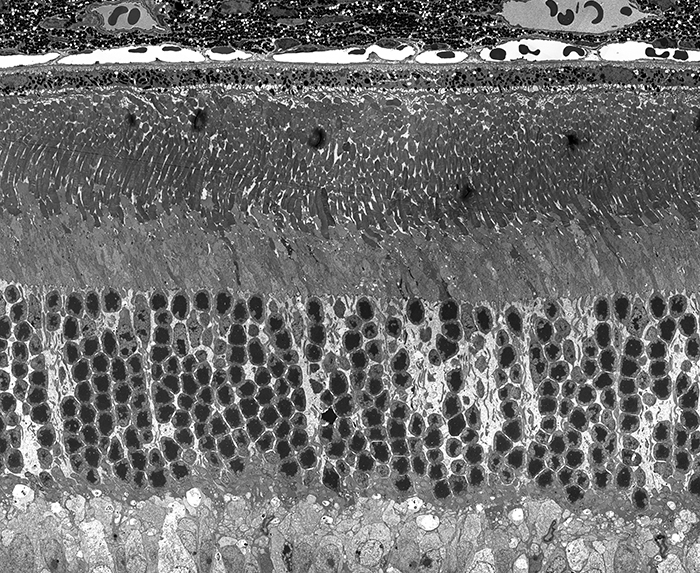We presented an abstract at the 2012 Retinal Degeneration meetings, The Alternative Complement Pathway Mediates Functional And Morphological Deficits In A Smoke Model Of Age-Related Macular Degeneration.
The authors were: Alex Woodell, Beth Coughlin, Kannan Kunchithapautham, Tucker Williamson, Carl Atkinson, William Ferrell, myself and Bärbel Rohrer as the senior authors.
BACKGROUND: Age-related macular degeneration (AMD) is among the leading causes of blindness in western populations. During the past ten years, two distinct lines of evidence have emerged suggesting the complement system may be involved in the pathogenesis of AMD. First, several complement proteins, activators, and inhibitors have been identified as molecular constituents of drusen, the hallmark extracellular deposits associated with dry AMD. Second, genetic studies have demonstrated polymorphisms in various complement proteins can increase the risk of developing AMD. However, smoking is the only proven modifiable risk factor for this optic neuropathy. Although previous studies have shown that smoke causes AMD-like defects in mice, little is known about the specific pathways involved.
METHODS: Mice were exposed to either cigarette smoke (CS) or filtered air for 6 hours/day, 5 days/week for 6 months. Smoke generated by the TE-10 cigarette-smoking machine is a mixture of cigarette mainstream (11%) and side-stream smoke (89%), which mimicks environmental tobacco smoke. Cigarettes were smoked using a standard puff profile of 35 ml volume of 2-second duration, with a total particulate matter in the exposure chamber equal to 90 mg/m3, and carbon monoxide concentration of 350 ppm. The effects of smoking were analyzed in wildtype (WT) or mice without a functional complement alternative pathway (AP) (CFB-/-). Retinal function was assessed by full-field electroretinography (ERG), spatial frequency and contrast sensitivity using an optokinetic response (OKR) paradigm, and retinal morphology by spectral-domain optical coherence tomography (SD-OCT) and electron microscopy (EM).
RESULTS: Retinal function was assessed using scotopic rod and photopic cone ERGs. While smoke-exposed WT mice exhibited a significant reduction in ERG amplitudes for both rods and cones, ERG amplitudes of AP-deficient mice remained unaltered with smoke exposure. Spatial frequency was determined at a constant speed (12 deg/sec) and contrast (100%); contrast threshold was measured using a blind “observational” technique by adjusting contrast in a simple staircase paradigm at fixed spatial frequency (0.131 cyc/deg) and speed (12 deg/sec). WT smoke mice showed a significant decrease in contrast threshold compared to non-smoke controls, while animals without a functional AP maintained the same response threshold. Spatial frequency exhibited a trend towards a decrease in WT, which was however not statistically significant. SD-OCT allows visualization of all major retinal layers with high axial resolution (4.5 μm). We captured spectral data at a fixed point approximately 0.5 mm from the optic nerve head in the nasal quadrant. Images of WT smoke mice revealed the anatomical consequences of retinal degeneration: thinning of the outer retina, including the outer and inner nuclear layer. Smoke-exposed AP deficient mice had shorter outer and inner segments compared to controls. Finally, using EM we showed that WT smoke mice have larger mitochondria and display an apical shift in mitochondrial distribution within the RPE, a thickening of Bruch’s membrane, and thinner rod outer segments compared to non-smoke controls and AP-deficient mice.
CONCLUSIONS: Taken together, these findings suggest an important role for the AP in the generation of complement-dependent injury in a smoke model of dry AMD. Improving our understanding of the regulation of this pathway is paramount to developing novel treatment approaches for AMD.
